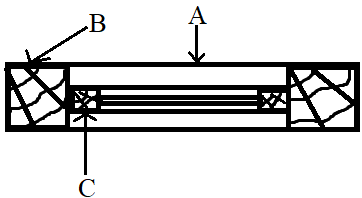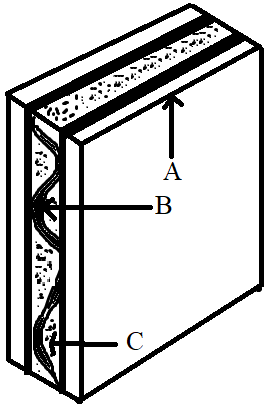This set of Building Construction Interview Questions and Answers focuses on “Types of Partitions – 2”.
1. Putty is made of __________
a) Mustard oil
b) Sunflower oil
c) Linseed oil
d) Peanut oil
View Answer
Explanation: Putty is a cementing material which is used to keep glass sheets in position while constructing glass sheet partition walls. Putty is made up of linseed oil and whiting chalk.
2. Glass sheet partition walls are not __________
a) Lightweight
b) Heavy
c) Sound-proof
d) Damp-proof
View Answer
Explanation: In glass sheet partitions, glass sheets are fixed in a wooden framework. Glass sheet partition walls are light in weight. They are sound-proof and damp-proof.
3. Which of the following is not a strong variety of glass?
a) Wired glass
b) Ordinary glass
c) Bullet-proof glass
d) Three-ply glass
View Answer
Explanation: Wired glass, bullet-proof glass and three-ply glass are all strong varieties of glass. However, ordinary glass is weak. It needs frequent replacement as well.
4. Hollow blocks used in glass partitions have a thickness of _________
a) 5 cm
b) 8 cm
c) 10 cm
d) 12 cm
View Answer
Explanation: Hollow blocks used in glass partitions have a thickness of 10 cm. They are usually square in shape with dimensions being either 14 x 14 cm or 19 x 19 cm.
5. The glass blocks are laid in _________
a) Lime mortar
b) Cement-lime mortar
c) Cement mortar
d) Mud mortar
View Answer
Explanation: The glass blocks used in glass partition walls are generally laid in cement-lime mortar. All the joints must be filled very carefully. They are painted on the internal edges and sanded on the external.
6. The thickness of plain sheets used to make asbestos partition is _________
a) 5 mm
b) 10 mm
c) 5 cm
d) 10 cm
View Answer
Explanation: There are two types of sheets used in asbestos partitions. These are plain sheets and corrugated sheets. The thickness of plain sheets used is 10 mm.
7. The thickness of corrugated sheets used to make asbestos partition is ________
a) 5 mm
b) 10 mm
c) 15 mm
d) 20 mm
View Answer
Explanation: Corrugated sheet is an inner sheet that is used in asbestos partitions. Plain sheets are attached to this inner corrugated sheet. The thickness of the corrugated sheets used is 5 mm. Cement mortar is used for joining the sheets.
8. Asbestos sheet partitions are weak and heavy.
a) True
b) False
View Answer
Explanation: In asbestos sheet partitions, asbestos sheets are fixed to a suitable wood framework to serve as a partition wall. Asbestos sheet partitions are lightweight and quite strong.
9. Which of the following partitions are made from burnt gypsum?
a) Metal lath partitions
b) Asbestos sheet partitions
c) Clay block partitions
d) Plaster slab partitions
View Answer
Explanation: Plaster slab partitions are made from burnt gypsum. Plaster of Paris can also be used instead of burnt gypsum. Metal lath partitions consist of channels with metal lath on one of their ends. Clay block partitions use clay blocks, either solid or hollow. Asbestos sheet partitions use asbestos sheets.
10. Sawdust is added to gypsum used in making plaster slab to ___________
a) Increase its weight
b) Reduce its weight
c) Impart colour
d) Impart odour
View Answer
Explanation: Sawdust is added to gypsum used in making plaster slab in order to reduce its weight. Instead of sawdust, other fibrous material may be used. Plaster slabs are good insulators of heat and sound.
11. Which of the following slabs show large movements with a change in moisture content?
a) Plaster slab
b) Concrete slab
c) Wood-wool slab
d) Metal slab
View Answer
Explanation: Wood-wool comprises of long wood fibres bound together with cement. Wood-wool slabs show large movements with a change in moisture content. Care must be taken in order to restrain such movements.
12. Whiting chalk used in the construction of glass partitions consists of _____________
a) Calcium bicarbonate
b) Sodium bicarbonate
c) Calcium carbonate
d) Sodium carbonate
View Answer
Explanation: Whiting chalk is made up of calcium carbonate. It is an ingredient used in making putty which is further used to secure glass sheets in sashes.
13. Reinforcement is placed in every course of hollow blocks used in glass partitions if the height of the block exceeds ___________
a) 10 cm
b) 15 cm
c) 20 cm
d) 25 cm
View Answer
Explanation: Hollow glass blocks are units of glass which are light in weight. They are available in various sizes and shapes. Reinforcement is placed in every course of hollow blocks used in glass partitions if the height of the block exceeds 25 cm. However, for blocks up to 15 cm in height, reinforcement is placed in every third or fourth course.
14. In the figure below, A represents __________

a) Stud
b) Groove
c) Nogging
d) Beading
View Answer
Explanation: The given figure is of an enlarged plan of a glass partition. In glass partition, a wooden framework is used which consists of horizontal and vertical posts. Here, A represents nogging, B represents stud and C represents beading.
15. In the figure given below, B represents ___________

a) Plain sheet
b) Corrugated sheet
c) Cement mortar
d) Concrete
View Answer
Explanation: The given figure represents an asbestos cement slab used in asbestos sheet partitions. Here, A represents a plain sheet, B represents corrugated sheet and C represents cement mortar.
Sanfoundry Global Education & Learning Series – Building Construction.
To practice all areas of Building Construction for Interviews, here is complete set of 1000+ Multiple Choice Questions and Answers.
If you find a mistake in question / option / answer, kindly take a screenshot and email to [email protected]
- Practice Civil Engineering MCQs
- Apply for Civil Engineering Internship
- Check Civil Engineering Books
- Check Construction and Building Materials Books
